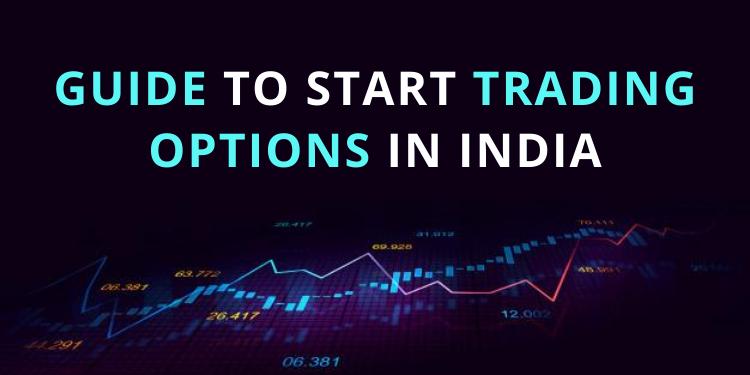A Beginner’s Guide on How to Trade Options in India: Options Trading has been quite popular in India in recent days. Because of the pandemic situation, a lot of new and existing traders have been able to understand and learn this new craft of trading (Options Trading).
Nonetheless, as the skills and steps required to trade Options is not taught in schools or academics, most beginners find it difficult to learn how to trade options in India. Therefore today, we are going to explain the step by step process on how to trade options in India in the easiest possible words. Let’s get started.
- Brief Overview of Options Trading
- Basic Options Trading Definition
- How to Trade Options In India?
- Closing Thoughts
Brief Overview of Options Trading
The most common concept that most of you must have heard about trading via options is the power to leverage.
Leveraging in terms of Options trading would simply mean, the power to trade at higher capacity then what the direct value of trade would allow. Let us understand this with the help of a simple scenario from day-to-day life.
Say, Ram has a wedding in his house two months down the line and for the purpose of the wedding, he needs to get 100 grams of Gold. The current price of 10gms of Gold is Rs. 50,000. However, Ram is a little skeptical about the volatility in the market and wants to lock in the current price of Gold, to be bought two months down the line. Therefore, with the objective of freezing the price of gold, he visits the jewelry shop and puts forward his proposition of buying the gold at the current price, two months down the line.
But looking at the current volatility, the jewelry shop owner is a little skeptical of taking the risk of fixing the price of Gold. Therefore, to incentivize the Jewelry shop, Ram pays him certain token money (say, Rs. 2000 per 10 gm of Gold) to fix the price of Gold. Therefore, the total money paid by Ram to enter the agreement with the jewelry shop owner is Rs. 20,000.
Let’s suppose, if upon expiry (i.e. after two months) if the price of gold goes above Rs 50,000 (per 10 gm), then Ram will exercise his right to buy the gold at Rs. 50,000. However, if the price of gold after two months remains unchanged or goes down, then Ram is not obligated to honor the agreement. He merely stands to lose the token money (Rs. 20000), which he paid to enter into the agreement. And that becomes the income of the Jewelry shop owner.
For example, if the price of Gold were to increase to Rs. 57,000 for 10 grams, then the overall benefit of Ram will be –
= Total gold * (Price after two months – Current price – Premium paid) = 10*10*(57,000-50,000-2,000) = Rs. 50,000.
Now, if I were to relate this example to options, then the Ram is the Option buyer, the Jewelry shop owner is the option seller, Gold is the underlying asset, the current price of gold is the Strike price and token money paid is the option premium.
A similar scenario is also applicable to the stock market. Here, if the option buyer believes that the price of a share may go higher in the future (through his analysis or study), he/she may pay a premium to the options seller to enter in a contract to buy the stocks at the pre-decided value. Further, the premium paid might be an expense, however, if the share price goes way above the pre-decided agreement price, then the option buyer will make profits.
Basic Options Trading Definition
To define in financial terms, Options are a derivative instrument that gives the right to option buyer to buy the underlying asset at a pre-decided price from the option seller, on or before expiry.
However, the option buyer is not obligated to honor the contract upon expiry. He has the right to buy the asset if he chooses to. However, if he does not wants to buy (in case the current price goes below the pre-decided value), he will simply lose the premium paid beforehand.
Nevertheless, the Option seller is obligated to honor the contract as he/she has taken a premium at the starting of the agreement. And the option seller is compensated in the form of this fee (or premium) to give up his right on underlying assets till the expiry of the contract.
How to Trade Options In India?
Now that you have understood the basics of Options Trading, we’ll be covering how to trade options in India next. For the sake of reference and explanation, I will be using the trading portal of Zerodha (Kite) in this article, as it is the most commonly used trading platform in India. Following are the step by step procedure to trade options in India.
Step 1: You need to have a trading account with one of the brokers (For example, Zerodha, Angel broking, 5Paisa, etc.). If you don’t have one, here’s an article on the best discount brokers in India so that you can pick the one that suits you the best. The steps to trade options in India are almost same in any trading platform you chose.
Step 2: We need to have a margin in our trading to be able to trade options. Based on the position taken by the investor, the margin requirement varies. Option buyer needs margin to pay for the premium required to trade options. And option seller needs margin as they have to keep certain money with brokers to account for Marked to Market (M2M).
Step 3: Next, we need to understand as to what is our view on the underlying asset. If we have a bullish view, then we can buy a call option (or sell put option) and if we have a bearish view, then we can express the same by either buying a put option (or selling a call option).
“Buying a Call option gives us the right to buy the underlying asset on or before expiry. And Buying a Put option gives us the right to sell the underlying asset on or before expiry”
Step 4: Select the underlying asset you chose to trade and also select the various strike prices that we choose to trade upon. For example, here’s a screenshot from Zerodha Kite where you can choose the asset and strike price.
Now, say we are looking to trade Nifty 50 Contract via Option and we have a bullish stance on the market. Therefore, we could trade In the Money Call Option (Nifty 11450 CE), At the Money Call Option (Nifty 11500 CE) or Out of Money Call Option.
It is advised to not to go too out of money while buying an option as the chances of them expiring in the money by expiry, is very less and more often than not, they expire worthlessly.
Step 5: Let’s say, we decide to go ahead and buy an At the Money option. Then, the next step in this process is to place an order to buy the option. We can choose to buy the option at the existing price and we can also choose to place the order at a specified price by placing a limit order.
Therefore, if you look at the ticket in the image above, we have two options to buy the contract from i.e. Market or Limit.
If we choose the option of market order then the order is executed at the current market price. And if we choose Limit order, then we can choose the price at which we want to buy the contact. In the image above, the current rice of the contract 11500 call option is 90.65, but the price at which we want to buy the contract is 80.
The total number of shares in one contract of nifty is 75. If the option premium is 60, then the total amount of premium required to buy the contract will be = 75*60 = 4500. And this information is directly available on the ticket shown above.
Step 6: The next step while trading options is to check in the order book if the order has been placed. We can do that by simply clicking on the orders tab and we can see the list of all the order which have been placed or canceled or executed.
Step 7: The last but the most important step while trading options is to monitor the existing position in the market. It is always advised to have a stop loss for every trade as it will help us in having good risk management and also prolong one’s trading career.
That’s all. This is how you trade options in India. If you still have any doubts, I will strongly recommend you to also watch the below video on how to trade options using Zerodha kite Demo. This video will help you even more to learn the steps for Options trading in India. Watch it Now!!
Closing Thoughts
In this article, we discussed how to trade options in India through a step-by-step guide. Here are the key takeaways from this article:
- Options are derivative products that derive their value form the value of the underlying asset.
- Call options give us the right to buy the underlying asset upon expiry. On the other hand, Put options give us the right to sell the underlying asset upon expiry
- Bullish views can be expressed by either buying a call option or selling a put option.
- Bearish views can be expressed by wither buying a put option or selling a call option.
- One can use the Zerodha platform to trade option as it is very user friendly and there is rarely any delay in the order execution.
If you still have any doubts on how to trade options in India, feel free to comment below. I’ll be happy to answer all your queries. Have a great day and happy trading!
Read & Write : write for us
 Lifeyet News Lifeyet News
Lifeyet News Lifeyet News





